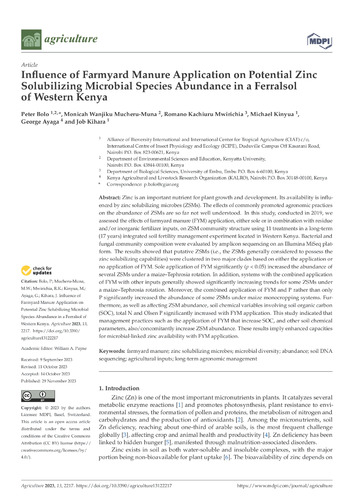Influence of farmyard manure application on potential zinc solubilizing microbial species abundance in a ferralsol of Western Kenya
Zinc is an important nutrient for plant growth and development. Its availability is influenced by zinc solubilizing microbes (ZSMs). The effects of commonly promoted agronomic practices on the abundance of ZSMs are so far not well understood. In this study, conducted in 2019, we assessed the effects of farmyard manure (FYM) application, either sole or in combination with residue and/or inorganic fertilizer inputs, on ZSM community structure using 11 treatments in a long-term (17 years) integrated soil fertility management experiment located in Western Kenya. Bacterial and fungal community composition were evaluated by amplicon sequencing on an Illumina MiSeq platform. The results showed that putative ZSMs (i.e., the ZSMs generally considered to possess the zinc solubilizing capabilities) were clustered in two major clades based on either the application or no application of FYM. Sole application of FYM significantly (p < 0.05) increased the abundance of several ZSMs under a maize–Tephrosia rotation. In addition, systems with the combined application of FYM with other inputs generally showed significantly increasing trends for some ZSMs under a maize–Tephrosia rotation. Moreover, the combined application of FYM and P rather than only P significantly increased the abundance of some ZSMs under maize monocropping systems. Furthermore, as well as affecting ZSM abundance, soil chemical variables involving soil organic carbon (SOC), total N and Olsen P significantly increased with FYM application. This study indicated that management practices such as the application of FYM that increase SOC, and other soil chemical parameters, also/concomitantly increase ZSM abundance. These results imply enhanced capacities for microbial-linked zinc availability with FYM application.

